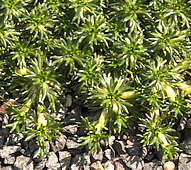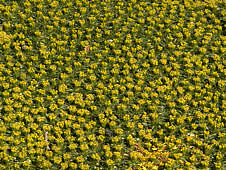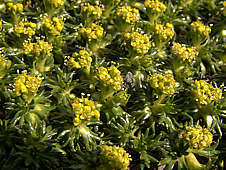The Apiaceae is a variable family including 300 - 400 genera and at least 2500 species of annual herbs, shrubs and trees, many with thickened or tuberous roots and hollow stems with deeply-cut, compound leaves. The inflorescence is usually an umbel of tiny, perfect or polygamous flowers with five petals and five stamens. Flowers are most commonly white or in some cases cream or pink. Typically, the flowers have stalks of different lengths so that all flowers are at the same height, producing an umbel with a flat top or many smaller umbels forming a single flat flower-head. The umbrella shaped flowerheads gave the family the original name, Umbelliferae. The family Apiaceae is named after the type plant Apium (Celery).
|
Crithmum Linnaeus 1753Crithmum is a monotypic genus for the succulent species Crithmum maritimum (Rock Samphire). |
|||
Crithmum maritimum (Rock Samphire), a native English scrubby, salt-tolerant succulent plant with branching stems and fleshy divided lanceolate leaves. It is found on coastal rocks, cliffs, walls, shingle and sandy soils, well above the high-tide mark but where salt spray can be carried on the wind. Heads of aromatic white flowers are produced in mid-Summer. |
|||
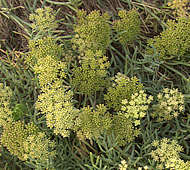 |
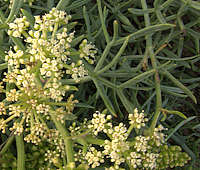 |
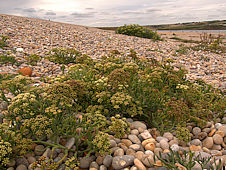 |
|
| Crithmum maritimum flowering in late August at Canford Cliffs, Dorset. | Crithmum maritimum flowering in late August on Chesil Beach, Dorset. | ||
This succulent plant is widely distributed along the Atlantic coast of Europe, Channel Islands, the Mediterranean and Black Sea.
The aromatic leaves are edible. Culpeper described them as having a "pleasant, hot and spicy taste" but to my palate they have a metallic after-taste, like Nasturtium seeds. The stems, leaves and seed pods may be pickled, or the leaves used fresh in salads.
|
|||



